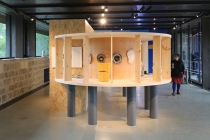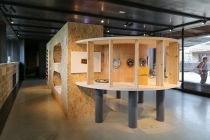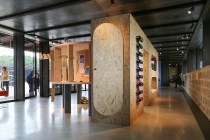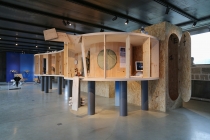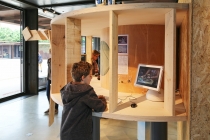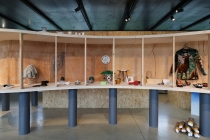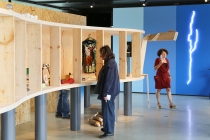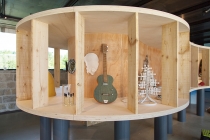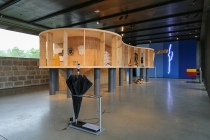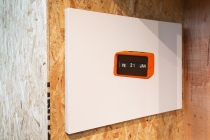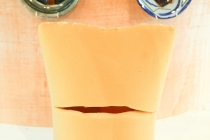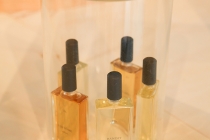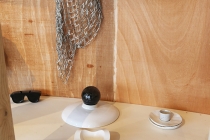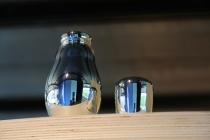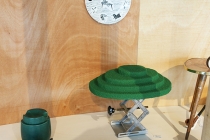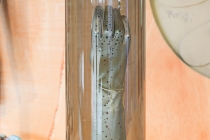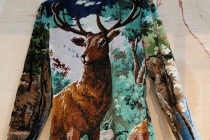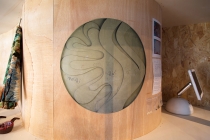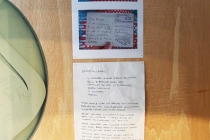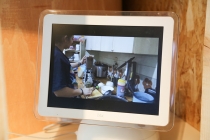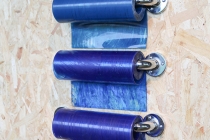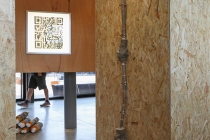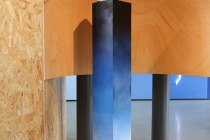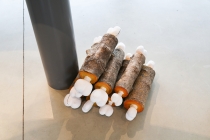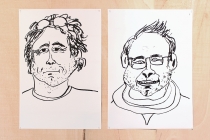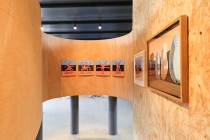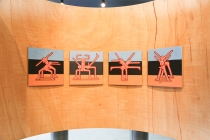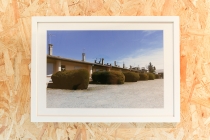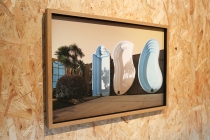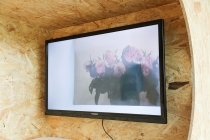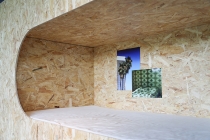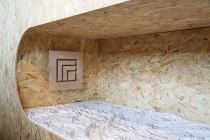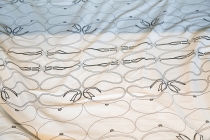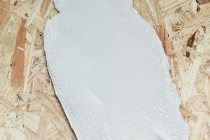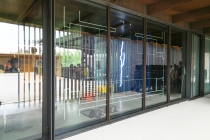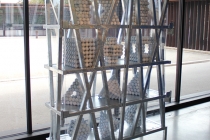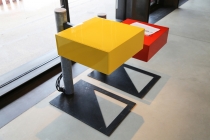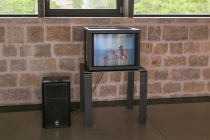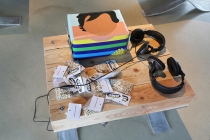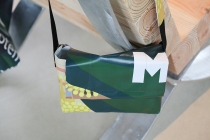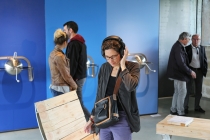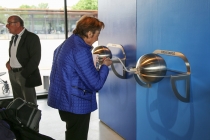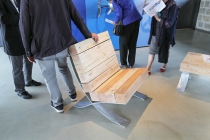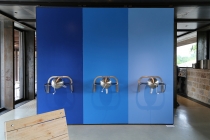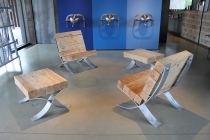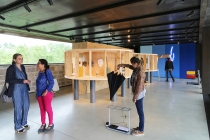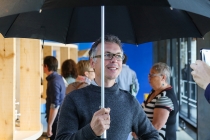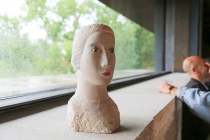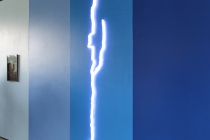Social sculpture, 2017-2019.
Plywood, OSB, PVC.
240 cm x 750 cm x 320 cm.
Group exhibition.
La Cuisine, Nègrepelisse.
3rd June until 17th September 2017.
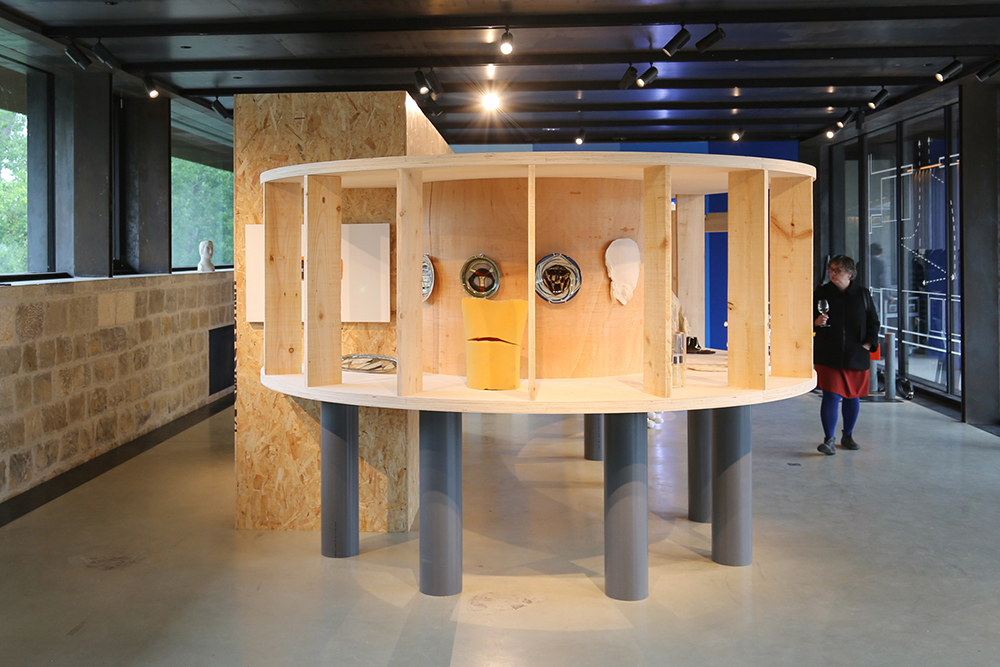
The origins of this exhibition by David Michael Clarke lie in a fascination and shared passion with Yvan Poulain, director of the art centre, La Cuisine, for the work of architect Roger Le Flanchec (1915 – 1986). An encounter with Madame Orain, who lives in one of his architectural utopias : the famous « bean house » developed into an artistic process, alive and convivial.
In DMC’s world, borrowing a formula from Robert Filliou, art isn’t about message, it’s about sharing. The artist brings together human and artistic relations, playing on many different registers of intervention: plastic gestures, popular references, modernist architecture, performative acts, games, music …
Here at La Cuisine, David Michael Clarke articulates his exhibition around a museographic structure inspired by Madame Orain’s house. Taking up it’s contours, DMC imagined the construction Clarke as a sinuous box into which the public could enter. Playing the role of artist-curator, DMC set up his stall in the marked steel and stone architecture of the art centre. Acting a little like a host, he invited many artists to come and share, cooperate, collaborate in this new architectural utopia.
Amused as he is by both minute details and approximative DIY construction techniques, DMC invites the public to come in and wander around his real-false architecture or to settle down in his alternative furniture.
A story of encounters
One day, without appointment, Yvan and I went to look at the « Bean House » situated in the village of Brélévenez, on the hill behind Lannion. Every house tells a story, and the story of this house is very much one of « encounters ». After the war, Emile Orain found himself in charge of the Youth Hostels of Brittany. The architect, Roger Le Flanchec had been invited to make a proposal for a new youth hostel on île Grande. His project, which looked like a cross between the starship Enterprise and a scallop stranded on rock, was rejected for technical reasons, but Monsieur Orain, no doubt impressed by the audacity of this atypic architect, decided to ask him to draw up plans for his own family home.
Madame Orain noticed us on the pavement and invited us in to visit her house, a sort of giant bean supported by a series of columns. As ever impassioned by her house, and welcoming as she is by nature, Madame Orain took us on a guided tour of her garden before showing us inside to look at the living spaces. Le Flanchec believed in the « synthesis of the arts », and so the house is full of artistic details, collaborations between himself and other artists or craftsmen who shared the same modernist vision. Inside, a glass corridor runs around the first floor. The woodwork is very reminiscent of small sailing boats. The bunk beds are built into a wooden « island » that follows the form of the house itself. Towards the end of the visit, Madame Orain announced like an impresario : « Now for la pièce de résistance … my kitchen ! ». She opened the doors to a large blue cupboard to reveal a modernist jewel. I wasn’t only captivated by the building, I was also very moved by warm aura that radiated out from Madame Orain, in and around the house. I immediately felt a resonance with the spirit that I wanted to evoke in my exhibitions.
Effectively for quite some years, I have distanced myself from the idea of the artist as a solitary figure that marked my early work and have moved more and more towards a collective practice. This process began with many small-scale artistic collaborations with my partner, Anabelle Hulaut, through to larger projects such as Post Gods and Flying Black Cow Club. It’s through working with other artists that I feel pushed towards new territories, places that I might not have explored if I had been left to my own devices. Every moment is a surprise. It’s a very positive force.
Marie Angelé
Everybody knows Marie Angelé as a visual arts counsellor for the DRAC Occitanie. Some of us remember her work as a curator at the Chapelle Saint-Jacques in Saint-Gaudens. However most ignore the fact that Marie studied at l’école des beaux-arts de Toulouse and that she can still, from time to time, find herself inspired into making artistic gestures.
Neal Beggs
Neal Beggs and I were students together on the MFA course at Glasgow School of Art. We then arrived in France together for a residency at Zoo Galerie, Nantes. Independently, we both decided to stay in France, each following his own love story. I’m still here. Neal is as well. Neal is well known for his work which links art to alpinism. However for the last few years, his eyes, or rather his ears have been turned towards the relation between music and landscape.
Hervé Beurel
Hervé Beurel is an artist and photographer based in Brittany with a strong interest in modern architecture. His exhibition, Carré Central, presented at the Galerie du Dourven in 2014, directly preceded my exhibition, Flying Black Cow Utopia Club. When I discovered his show, I asked him straight away if he could leave everything as is, and if I could hang my show inside of his.
Florence Carbonne
I have crossed paths with Florence Carbonne many times over the last few years. However our friendship really consolidated itself during my long trip to the Midi-Pyrénées region in 2015. We visited so many exhibitions together, and as Florence’s work is quite sensory, we carried out some off-beat adventures such as nocturnal visits to the sunflower swimming pools designed by architect Bernard Schoeller.
Christelle Familiari
As Neal and I arrived in France in 1999, Christelle Familiari went to Scotland. It was an exchange. Since then, I have followed the Christelle’s tactile work. I find quite remarkable the way in which she is able to play on many registers at the same time, from political to poetical, from radical feminism to sensory formalism.
Maxwell James Farrington
I first met Maxwell James Farrington in the nocturnal streets of Toulouse. In his drunken stupor, he was singing Frank Sinatra hits for all he was worth. Two antipodean anglophones we became inseparable, and as a pretext to see each other again and again, we began a musical adventure together. The first concert was held outside the Musée Calbet on the occasion of the opening of the exhibition, The Stuff of Dreams in 2016.
Yohann Gozard
Night time in Toulouse is also Yohann Gozard’s favourite ambiance. Rather than loitering in the heart of the ancient pink-brick city, Yohann tends to explore the deserted commercial centres and the wastelands in the city’s suburbs. The shutter speed is so slow that on first view one can confuse night with day. I was particularly drawn to the series of photographs taken in the forecourts of businesses that sell swimming pools. The pools are erected like monuments to haricot beans.
Bonella Holloway
Bonella Holloway avait déjà fini ses études lorsque je suis arrivé à l’isdaT, mais elle assurait une présence intra-muros avec ses performances. Tous les jours, elle filme des scènes de son quotidien. On peut dire qu’elle est héritière de Jonas Mekas. Les montages de Bonella intitulés tapas sont des chansons visuelles plutôt que des films sonores.
Anabelle Hulaut
J’ai toujours été fasciné par Anabelle Hulaut et son travail. Nous vivons ensemble et partageons nos idées, nos doutes, nos espoirs. L’échange artistique entre nous deux est un flux permanent. Pourtant, nous ne signons que rarement à deux. À chacun son univers. Celui d’Anabelle et autant littéraire que plastique.
David Kidman
J’ai rencontré David Kidman à l’école des beaux- arts, ESBA-TALM. Nous étions alors collègues et nous avons mené ensemble plusieurs ateliers « à vitesse réduite », se déplaçant en vélo pour tourner des films sur pellicule. Les œuvres de David Kidman s’appuient sur la confiance que nous prêtons au lm argentique, tout en confrontant l’actualité de la technologie numérique qui est devenue omniprésente.
Victoria Klotz
J’ai rencontré Victoria Klotz en accompagnant Jackie-Ruth Meyer et Patrick Tarres pour une « visite d’atelier » entre les sommets des Pyrénées. L’activité de Victoria est double, basculant entre une production sculpturale et une culture maraîchère spécialisée. Chez Victoria il y a tant d’expérimentations dans les deux domaines qu’il n’est pas facile de saisir la frontière entre les deux. Il n’y en a peut-être pas.
Xavier Krebs
Xavier Krebs est un peintre et céramiste important du mouvement abstrait d’après guerre. Il a collaboré avec son camarade breton, l’architecte Roger Le Flanchec, à plusieurs reprises et notamment sur la « maison Orain ».
Guillaume Pinard
Guillaume Pinard est aussi un peintre breton, mais ses préoccupations artistiques sont loin de celles de Xavier Krebs. Guillaume nous donne à voir un monde, notre monde, mais à travers un prisme qui lui est propre. C’est une vision du bonheur et de la tristesse, optimiste et apocalyptique, profondément triste et très, très drôle.
Marianne Plo
Marianne Plo est une artiste et une performeuse pleine d’énergie. Son univers surréel, chimérique, multicolore est comme une explosion hallucinogène, un portail entre notre monde banal et l’espace du rêve où tout est possible.
Philippe Poupet
Philippe Poupet est un sculpteur qui ne travaille pas sans humeur, transformant des objets banals en créatures burlesques, modifiant notre environnement quotidien pour qu’il devienne un jardin enchanté.
Babeth Rambault
Babeth Rambault déambule dans le monde comme quelqu’un qui en a perdu le mode d’emploi. Elle voit les mêmes choses que nous, sauf qu’elle a oublié à quoi ça sert. Elle essaye de rassembler ces fragments du réel, en testant chaque pièce, l’un à côté de l’autre comme on fait avec un puzzle. Ainsi, elle nous offre une image de notre monde plus étrange que jamais.
Anne Santini
Anne Santini n’a pas de travail artistique proprement dit. Pourtant elle a fait des études aux beaux-arts de Nîmes, elle transforme des choses, elle produit des choses et elle organise des événements insolites. En empruntant les mots de Jean-Yves Jouannais, elle est peut-être artiste sans oeuvre.
Katharina Schmidt
J’ai rencontré Katharina Schmidt à l’isadT. À cette période, avec le critique d’art Hervé Sénant, je faisais tous les quinze jours le tour des ateliers des étudiants pour parler peinture. Le travail de Katharina, léger, souvent éphémère, des fois drôle, tient tant au contexte architectural qu’à la peinture elle-même.
Bertrand Segonzac
Le monde peint par Bertrand Segonzac semble incomplet. Il manque toujours quelque chose car souvent l’objet a été extrait de son contexte. Les objets qu’il choisit de représenter viennent d’une autre époque, un passé pas si lointain. Bertrand nous montre la défaillance de notre mémoire collective.
Laurent Tixador
J’ai rencontré Laurent Tixador à Glasgow. Nous étions alors de jeunes artistes qui travaillaient comme régisseurs pour mettre du pain sur la table. Quelques années plus tard, nous nous sommes retrouvés à Nantes. Comme moi, Laurent est bien capable d’inventer un problème afin de trouver une solution pour ce problème qui n’existait pas.
Elsa Tomkowiak
Elsa Tomkowiak cherche à appliquer la peinture, et surtout la couleur, dans l’espace sur le minimum de supports. Ainsi, elle est arrivée à peindre sur divers plastiques transparents, même sur du film étirable. Ces plans de couleur sont découpés précisément et par la suite installés dans un environment généralement urbain afin de définir de nouveaux espaces.
Béatrice Utrilla
Béatrice Utrilla est vidéaste. Elle capture des fragments du réel, et nous invite à reconstuire, ou plutôt simplement construire une nouvelle réalité. Si la camera peut fonctionner souvent comme un seuil entre l’observateur et le monde, chez Béatrice ce n’est pas le cas car les principes de complicité et de collaboration son au cœur de sa pratique.
Juliette Wouth
Juliette Wouth est une jeune artiste qui était étudiante à l’isdaT. Elle aussi a une pratique collective, incitant d’autres à chercher dedans, pour des talents qu’ils avaient laissés dormants ou en s’engageant dans des projets de dessins communautaires.
List of works
1. Anabelle Hulaut – Moulins à Menus. Sculpture. 2015. Inox, balles de ping-pong, fiches à remplir.
2. David Michael Clarke – Salon Barcelona (d’après Mies Van Der Rohe]. Sculpture. 2017. Acier galvanisé, Douglas pin.
3. Anne Santini – DMC Corps. Installation. 2017. Sacs besace en bâche, sachets de mogettes, bande sonore.
4. David Michael Clarke – Balade pour Rudy & Gilles. Vitrine & Sculptures. 2017. Acier galvanisé, Plexiglass, balles de golf.
5. Béatrice Utrilla, Bertrand Arnaud – Je te quitte. Vidéo. 2008. 4 minutes.
6. Béatrice Utrilla – (couchette haut). Photographies et vidéo. 2017.
7. Katharina Schmidt – Bohnen (couchette bas). Tirage numérique sur coton. 2017.
8. Bertrand Segonzac – Matrice-motif (couchette bas). Relief. Bois. 2017.
9. Laurent Tixador – Electroplatane. Sculpture. Bois, circuit électrique. 2015.
10. Elsa Tomkowiak – Rolls. Relief. 2014 & 2017. Encre de sérigraphie sur lanière de PVC, acier chromé.
11. Maxwell James Farrington – Singing in the bathroom. Bande sonore. 20 minutes.
12. David Michael Clarke – Rietveld Montauban. Fauteuil. 2014. Bois peint, basin PVC.
13. Florence Carbonne – Fissure. Installation. 2011. Plexiglass, LEDs, photographie, bande sonore.
14. Christelle Familiari – Les gardiens. Sculptures. 2015. Laine crochetée trempée dans le ciment, barre d’aluminium.
15. Katharina Schmidt – La cuisine de Grete. Installation. 2017. Peinture sur vitre.
16. David Michael Clarke – Holophane Judd. Lampadaires récupérés. 2015 Dimensions variables.
17. Philippe Poupet – Petouille de décoffrage. Sculpture. 2017. Bois.
18. Neal Beggs – Those Bones. Sculptures. 2013. Bois peint.
19. David Kidman – Hollywood on a stick. Sculpture. 2017. Parapluie préparé.
20. Bertrand Segonzac – Sans titre (Racks). Peinture. 2011. Acrylique sur toile.
21. Xavier Krebs – Assiettes. 3 assiettes et 1 plat creux. 1953. Faïence émaillée.
22. Babeth Rambault – Sans titre (provisoire). Sculpture. 2017. Mousse synthétique.
23. Victoria Klotz – Effluves. Sculpture. 2011. Flacons de parfum.
24. Neal Beggs – 24 inch scale guitar. Sculpture. 2017. Bois.
25. David Michael Clarke – Proposition pour un arbre. Sculpture. 2016. Acier peint.
26. Christelle Familiari – Ensemble de pièces. Etudes pour services de table. 2017. Porcelaine, grès, ciment, verre.
27. Anabelle Hulaut – Ensemble de pièces. La trahison d’une pipe. 2007. Bois, cuir, paillettes, mousse. Lunettes de Romans. 2016. Emporte-pièce en inox. Le monte monts et l’élévateur de collines. 2014. Metal et matériaux divers. Valise à loupe. 2009. matériaux divers. Trois modèles de pipes (le moule, le four, la demi). 2013. Terre cuite. Extraits de collection de pipes. Faïence et matériaux divers.
28. Marie Angelé – Veste.
29. Victoria Klotz – Gant de séduction. Sculpture. 2011. Cuir d’agneau. Tirage numérique.
30. Hervé Beurel – Détail du tableau N°11, Berlin. Photographie. 2006 & 2017. Impression numérique sur papier dos bleu.
31. Bonnie Holloway – Postcard from Mexico. 2017. Vidéo, postcard, ingrédients en état de décomposition, recette.
32. Marianne Plo – Sans titre. Sculpture. 2015. Marbre.
33. Marianne Plo – Sans titre. Sculpture. 2015. Albâtre.
34. David Kidman – Portrait of Marie-Hélène Breuil. 2016. Interactive film object. 16mm film, lightbox, iPad.
35. Juliette Wouth – Portraits de David Michael Clarke & Yvan Poulain. Dessins. 2017.
36. Yohann Gozard – Wonderpools. Photographie. 2012.
37. Babeth Rambault – Cocoon. Photographie. 2013.
38. Guillaume Pinard – Les Acrobates. 4 tableaux. 2017. Acrylique sur toile.
Une exposition produite par La Cuisine centre d’art de Nègrepelisse, avec la participation de l’Artotheque de Vitré et du FRAC Normandie Caen.
Madame Orain at home (film)
Following in the footsteps of Rudy & Gilles (résidence)
Ballad for Rudy & Gilles (sculpture)
Barcelona suite (all-weather version)
Neal Beggs
Hervé Beurel
Florence Carbonne
Christelle Familiari
Yohann Gozard
Bonella Holloway
Anabelle Hulaut
David Kidman
Victoria Klotz
Guillaume Pinard
Marianne Plo
Philippe Poupet
Babeth Rambault
Katharina Schmidt
Bertrand Segonzac
Laurent Tixador
Elsa Tomkowiak
Béatrice Utrilla

